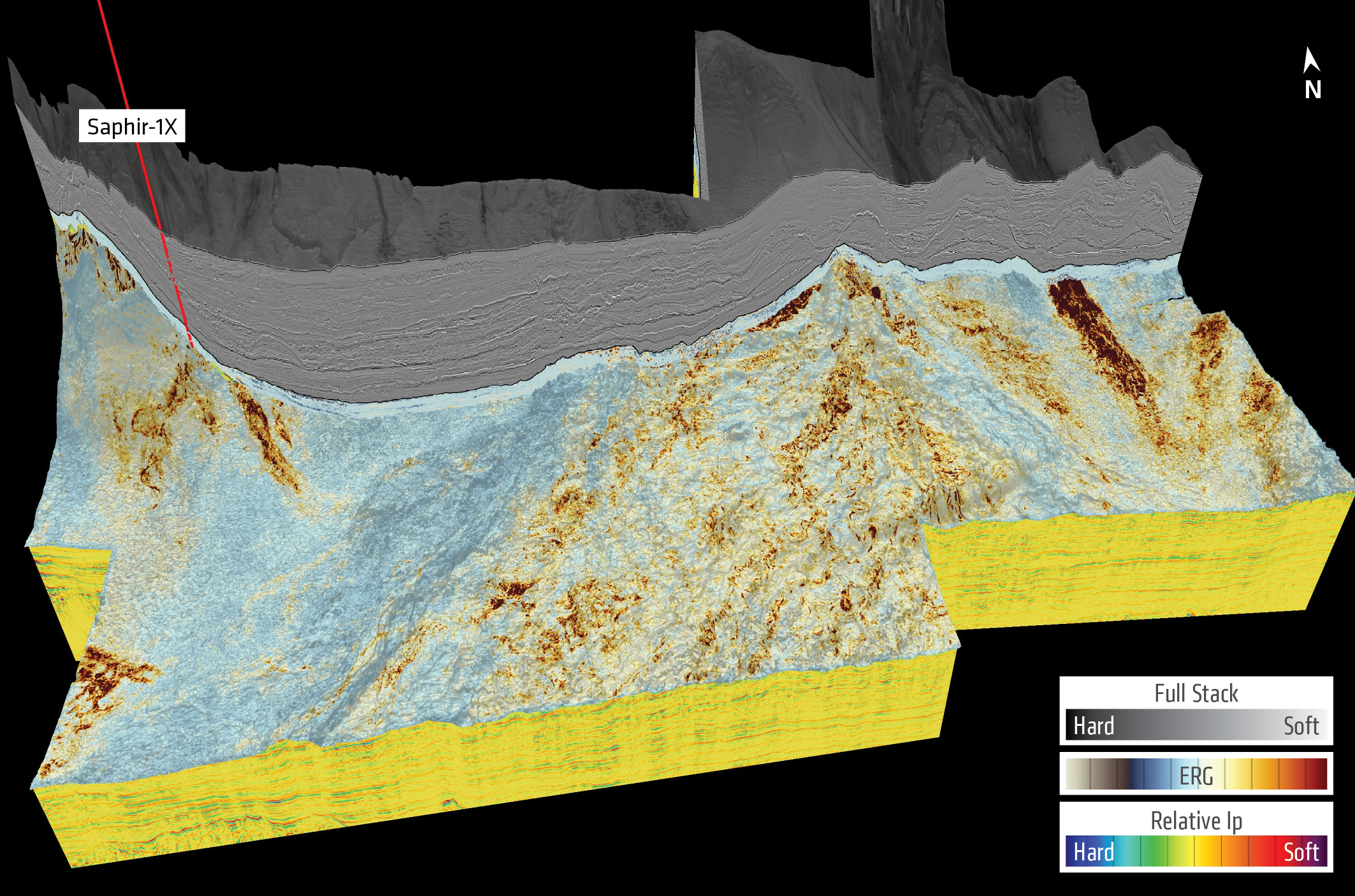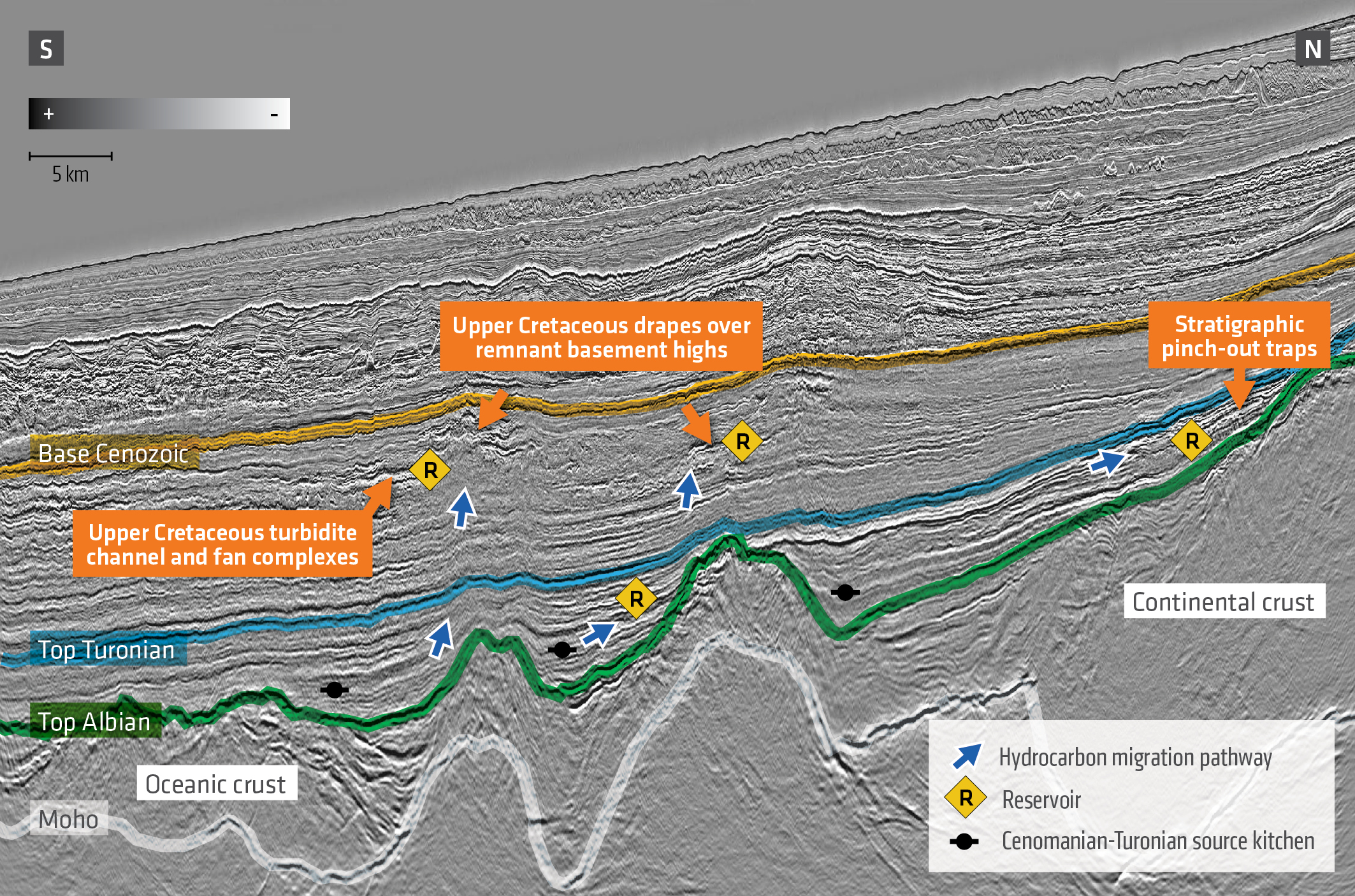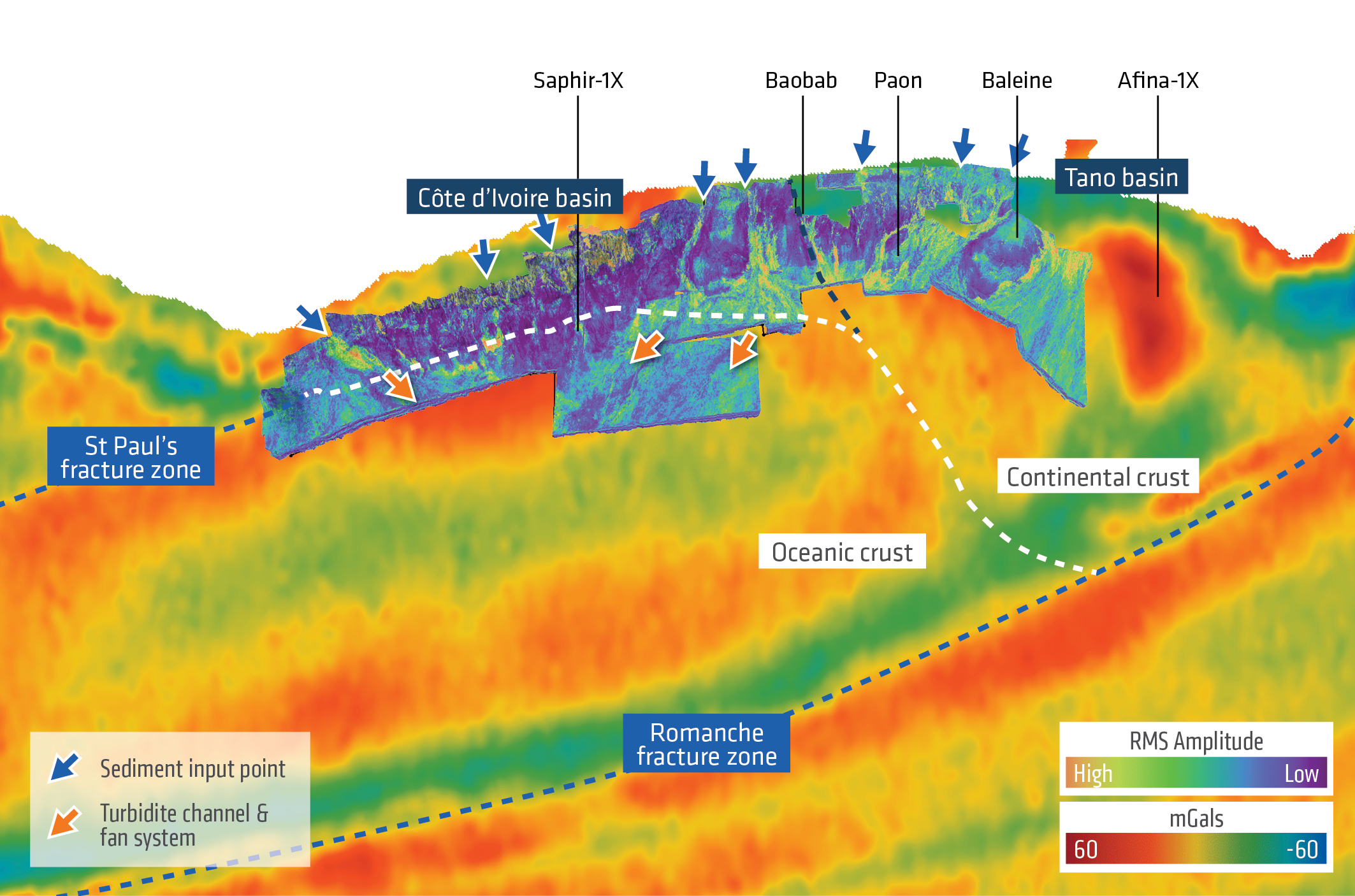The Tano Basin has been the location of several high-profile discoveries made in recent years with the drilling of the Afina-1X well in Ghana and the discovery and subsequent expansion of the Baleine structure offshore Côte d’Ivoire.
These large accumulations have shown that there are significant volumes of hydrocarbons being found in Cretaceous-aged plays over continental crust in this well-explored basin. Using insights gained from extensive PGS MultiClient seismic data coverage, new play concepts from recent discoveries offshore Namibia can be applied directly to Côte d’Ivoire.
This enhanced regional scale understanding of petroleum systems highlights the remaining opportunities over oceanic crust in the western area of the Côte d’Ivoire offshore, allowing exploration potential to be extended from analogs and existing in-basin discoveries into underexplored areas.

Tectonic history key to petroleum system development
Offshore Côte d’Ivoire can be split into two main basins, the Tano Basin in the east and Côte d’Ivoire Basin in the west. Both depocenters developed during the opening of the Atlantic, with transtensional rifting beginning in the Early Cretaceous and finishing at the end of the Albian with the formation of oceanic crust.
The Tano Basin developed in an area of relative tectonic quiescence between the Saint Paul’s and Romanche Fracture Zones, resulting in pull-apart grabens with a thick clastic fill. This created a broad shelf to deep water profile with the basin underpinned by thick continental crust, gradually thinning towards the continental to oceanic crustal transition.
In comparison, the Cote d’Ivoire Basin has a narrow shelf to deep water profile, characterized by transtensional faulting and initial graben development orientated subparallel to the present-day coastline. The continental to oceanic crustal transition is also more abrupt here due to the underlying Saint Paul’s Fracture Zone.
The stratigraphic section of both areas can be divided into the pre-, syn- and post-transform tectonic phases, each with a distinct depositional history and related petroleum systems. The pre-transform stage has not been penetrated by drilling in the Côte d’Ivoire Basin and so we will focus on the syn- and post-transform stages due to their contribution to proven petroleum systems.
The syn-transform phase of transtensional opening in the Gulf of Guinea began around the Berriasian and ceased at the end of the Albian. A thick section of continental to marginal marine clastics was deposited during this period, providing potential reservoir units in the form of fluvial to marginal marine sandstones. Source rocks transition from deeper Aptian lacustrine shales to shallower Mid-Albian marginal marine shales through the stratigraphic section as rifting progressed.
Extensional opening of the Transform Margin basins ceased at the end of the Albian and was followed by wide-spread deposition of Cenomanian-Turonian marine shales. The area formed a continuous anoxic seaway from the late Albian to Turonian, which resulted in a high total organic carbon content (TOC) oil-prone source rock in the region.

Regional data coverage for enhanced understanding of prospectivity
In partnership with PetroCi and Direction Générale des Hydrocarbures, PGS has a large footprint of MultiClient seismic data available offshore Côte d’Ivoire (see map). The recently expanded CDI MegaSurvey offers almost complete west to east coverage of the Ivorian offshore with 33,861 sq. km of 3D and 31,743 line km of 2D.
The various 3D input datasets have been matched, merged and re-binned onto a common grid resulting in a single, continuous volume of full-stack seismic data in the time domain, allowing for regional scale play analysis. Overlying the western portion of this dataset are several broadband GeoStreamer surveys where pre-stack data has been used to perform AVA analysis, enhancing the understanding of the prospectivity in the region.
Exploration history of the two key plays
Two main plays have been the focus for exploration in the Ivorian offshore; the syn-transform Lower Cretaceous and the post-transform Upper Cretaceous. The Lower Cretaceous play dominates the area around the shelf edge in both the Tano and Côte d’Ivoire Basins. A contributing factor in this inboard dominance is the source rock maturation history.
Berriasian to Albian source rocks sit within the gas maturity window around the shelf due to a relatively thinner overburden, whereas they are likely to be over-mature in more distal syn-transform basins where depth of burial is greater. These source rocks are paired with Albian aged fluvial to shallow marine syn-transform sandstones, as proven in the Baobab Field.
The Upper Cretaceous system is most successful around and outboard of the present-day shelf edge due to the thick clastic section allowing for sufficient burial of shallower Cenomanian-Turonian aged source rocks. These type II source rocks have mixed oil and gas potential. Complementing this widespread source kitchen are Albian to Santonian aged shallow to deep marine sandstone reservoirs.
The largest discovery in this play is contained within the Baleine shelf-edge structure which is reported by Eni to contain 2.5 billion barrels of oil and 3.3 trillion cubic feet (TCF) of associated gas over two main reservoir levels. This discovery has also expanded the Upper Cretaceous play to include carbonate shelf edge reservoirs.
The Paon discovery by Anadarko has proven that the Upper Cretaceous play extends into the deep water Tano Basin, with the Saphir-1X well drilled by Total illustrating that the play is present to the west in the Côte d’Ivoire Basin too.
As shown by the RMS amplitude extraction from the Upper Cretaceous in the headline image, turbidite channel and fan complexes, annotated by the orange arrows, are widely deposited across the entire Ivorian offshore. Multiple sediment input points (blue arrows) are observed in both the Tano and Côte d’Ivoire Basins, highlighting the promising reservoir potential to the west of the Tano Basin. These features are also highlighted using pre-stack data (left), which indicate AVA anomalies in the deep-water area.

Deep water play concepts from Namibia
Recent 2022 exploration success offshore Namibia with TotalEnergies’ Venus-1 and Shell’s Graff-1 and La Rona-1 discoveries have suggested that Cretaceous-aged source rocks deposited over transitional to oceanic crust are oil mature in outboard areas, expanding the Cretaceous play into the deep-water in the Orange Basin.
The concept for hydrocarbon generation and expulsion from source rocks subjected to increased heat flow due to a shallow aesthenosphere may also be applied to the deep water offshore of Côte d’Ivoire, expanding prospectivity beyond the area underpinned by continental crust in both the Tano and Côte d’Ivoire Basins.
Applying seismic facies analysis to the section shown here (see seismic section above), Cenomanian-Turonian-aged source rocks are hypothesized to have been deposited directly over transitional to oceanic crust. These deposits are characterized by their low amplitude, planar response typical of deep-water shale deposits. The Cenomanian-Turonian-aged shales are a proven source rock offshore Côte d’Ivoire, containing high TOCs.
Similarities can be drawn between the location of the Namibian discoveries over transitional to oceanic crust and the extension of potential Upper Cretaceous reservoirs into the deep-water offshore of Côte d’Ivoire. Using Bouguer Corrected Gravity data and through mapping of the Moho on the seismic, these turbidite channel and fan complexes are observed to extend beyond the continental-oceanic crustal transition. These reservoirs, where draped over oceanic crustal highs and paired with underlying Cenomanian-Turonian potential source rocks, hint at exciting further exploration opportunities in the Côte d’Ivoire Basin.
Images courtesy of PGS




